Child Welfare Training in a Box®
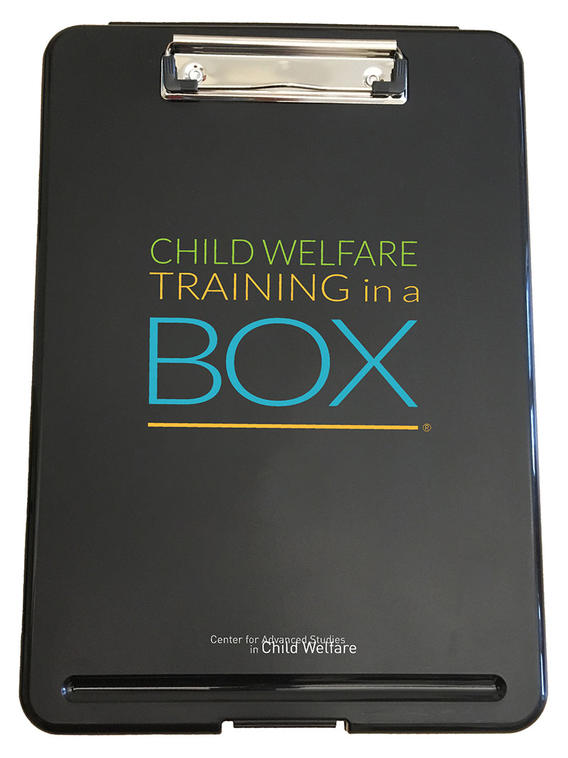
This training tool was developed for professionals working in the field of child welfare by the Center for Advanced Studies in Child Welfare (CASCW) and various collaborators.
Why Child Welfare Training in a Box®?
Child welfare workers maintain busy and demanding schedules, often making it difficult to fit in training. The Child Welfare Training in a Box® method allows us to provide you with high quality training on the go. Training that you can complete at your own pace and at your own convenience.
How does it work?
The goal is for child welfare units and teams to be able to choose relevant training material and distribute over time. Each member of a unit is encouraged to review the box materials for up to one week to allow for time to watch the videos, read the practice briefs, and review the resource cards.
After you review the training:
- Exchange the box with a team member who hasn't yet completing the training.
- Process the information you have learned with your colleagues. Think of any questions you had as you went through the materials.
- Share your thoughts in supervision and/or at a team meeting.
- Encourage other professionals you work with to access this information online.
Below, please find descriptions of the materials included in this training kit.
To request Child Welfare Training in a Box sets and materials for your unit or team, please email cascw@umn.edu and specify which topic(s) you're interested in.
Box 1: Supporting Parents with Co-occurring Disorders (CODs) in Child Welfare (CASCW in partnership with CPT)
Video Card
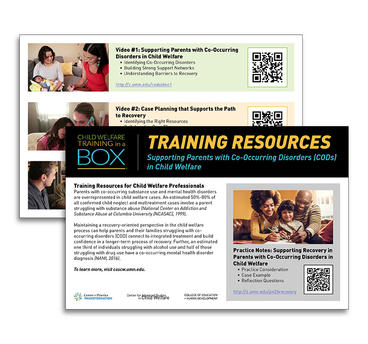
The Video Card: Highlighting a three-part video series that will help you and your team identify signs of CODs, understand barriers to recovery for clients, improve case and safety planning, and recognize the importance of integrated treatment options for families managing CODs in child welfare.
- Video #1: Supporting Parents with Co-Occurring Disorders in Child Welfare
- Video #2: Case Planning that Supports the Path to Recovery
- Video #3: Integrated Approaches, Bias, and Meeting Parents Where They Are
Practice Notes
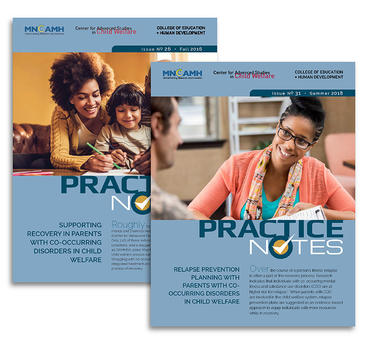
Practice Notes: Two Practice Note publications on informational topics for child welfare practitioners to reference. Practice Notes link innovative research with best practices in child welfare.
- Supporting Recovery in Parents with Co-Occurring Disorders in Child Welfare
- Relapse Prevention Planning for Parents with Co-Occurring Disorders in Child Welfare
Practice Tips
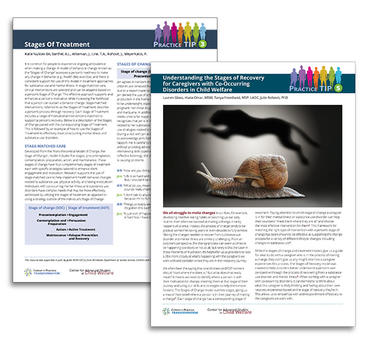
Practice Tips: Two Practice Tips on informational topics for child welfare practitioners to reference. Practice Tips link innovative research with best practices in child welfare.
- Stages of Treatment
- Understanding the Stages of Recovery for Caregivers with Co-Occurring Disorders in Child Welfare
COD Resource Booklet
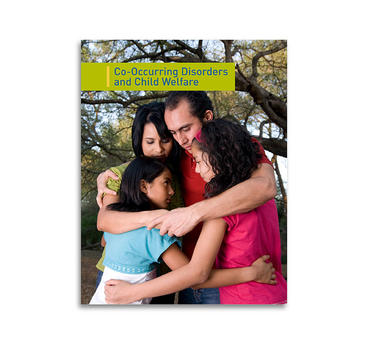
COD Resource Booklet: This booklet provides information on many aspects of CODs and recovery for individuals simultaneously navigating the child welfare system.
- Think of the booklet as your companion in the field. Reference the cards at anytime to refresh your knowledge, try new approaches, or connect individuals to local integrated treatment options and resources.
Box 2: Children with Disabilities in Child Welfare
Training Resource Card
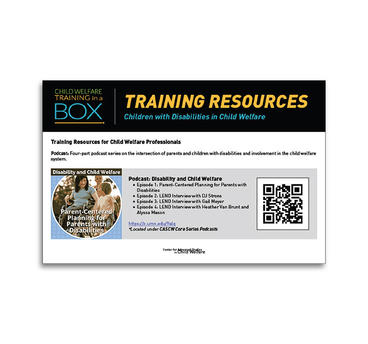
Training Resource Card: A four-part series on the intersection of parents and children with disabilities and involvement in the child welfare system.
Podcast: Disability and Child Welfare
Research Resources
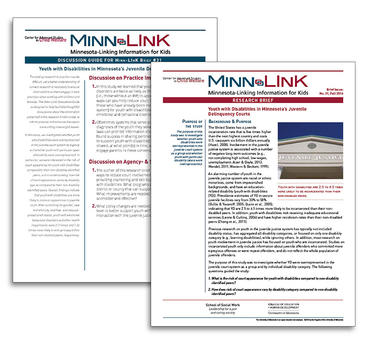
Minn-LInK Research Briefs: Minn-LInK Research briefs provide opportunities to understand the experiences of children and families who are served by multiple systems by linking longitudinal data from multiple systems to answer questions about the effects of policies, programs and practice on the well-being of children and families in Minnesota.
- ML Brief #31: Youth with Disabilities in Minnesota's Juvenile Delinquency Courts
- ML Brief #32: Autism, Service Delays and Educational Outcomes
- ML Brief #40: Children with Autism Spectrum Disorder in Child Protection: Disparities, Allegations and Services
Minn-LInK Research Brief Discussion Guides: The Minn-LInK Discussion Guide is designed to help facilitate thoughtful dialogue about the information presented in the research brief in order to inform practice and enhance discussion surrounding meaningful issues. Translating research to practice may be difficult, yet a better understanding of current research is necessary to ensure child welfare workers, educators, and other professionals engage in best practices when working with children and families.
Disability Resource Card
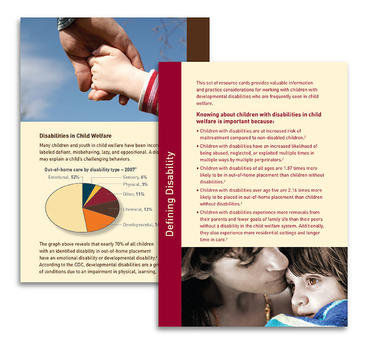
Disability Resource Card: Resource cards providing definitions of different types of disability, rates of prevalence and practice suggestions for working with children with different disabilities.
Policy Resource
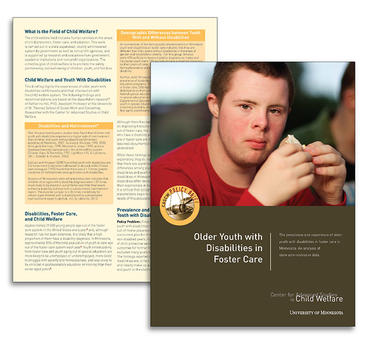
Policy Brief: A Policy Brief providing a briefing on the prevalence and experience of older youth with disabilities in foster care in Minnesota using an analysis of state administrative data.
- Policy Brief #5: Older Youth with Disabilities in Foster Care.
CW360° Publication
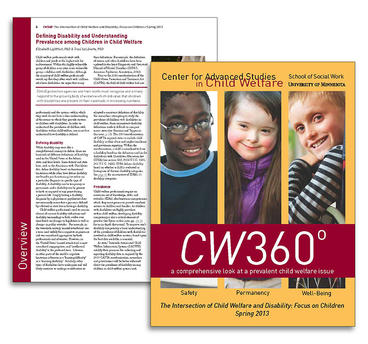
Child Welfare 360° (CW360°) is an annual publication that uses a multidisciplinary approach for its robust examination of an important issue in child welfare practice. This box includes an issue focused on the issues of children with disabilities in the child welfare system, a population that is overrepresented in child welfare.
Spring 2013 Publication: The Intersection of Child Welfare and Disability: Focus on Children (CW360°)
Box 3: Parents with Disabilities in Child Welfare
Training Resource Card
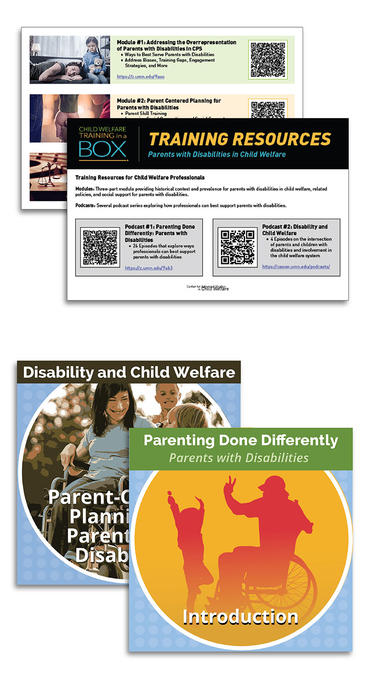
Online Modules: Three-part module providing historical context and prevalence for parents with disabilities in child welfare, related policies, and social support for parents with disabilities.
- Module #1: Addressing the Overrepresentation of Parents with Disabilities in CPS
- Module #2: Parent Centered Planning for Parents with Disabilities
- Module #3: Parents with Disabilities in Child Welfare
Podcasts: Several podcast series exploring how professionals can best support parents with disabilities.
- Module #1: Parenting Done Differently: Parents with Disabilities
- Module #2: Disability and Child Welfare
Research Resources
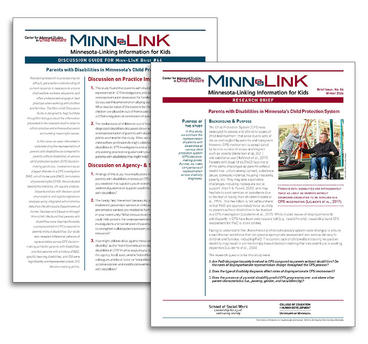
Minn-LInK Research Brief #64: A Minn-LInK Brief describing the characteristics of parents with different types of disabilities and their representation at various child protection system (CPS) decision-making points.
- ML Brief #64: Parents with Disabilities in Minnesota's Child Protection System
Minn-LInK Research Brief #64 Discussion Guide: The Minn-LInK Discussion Guide is designed to help facilitate thoughtful dialogue about the information presented in the research brief in order to inform practice and enhance discussion surrounding meaningful issues. Translating research to practice may be difficult, yet a better understanding of current research is necessary to ensure child welfare workers, educators, and other professionals engage in best practices when working with children and families.
Policy Resources
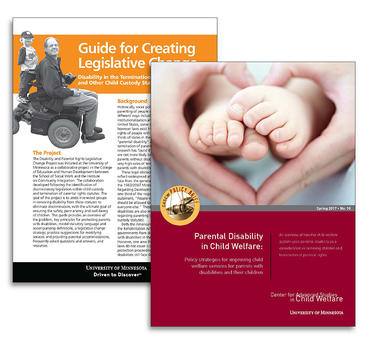
Policy Brief: A Policy Brief providing an overview of how the child welfare system uses parental disability as a consideration in removing children and termination of parental rights.
- Policy Brief #10: Parental Disability in Child Welfare
Guide for Creating Legislative Change: This guide provides key principles for protecting parents with disabilities; model statutory language and accompanying definitions; a legislative change strategy; and practice suggestions for modifying services and providing parental accommodations.
- Policy Guide: Guide for Creating Legislative Change: Disability in the Termination of Parental Rights and Other Child Custody Statutes
CW360° Publication
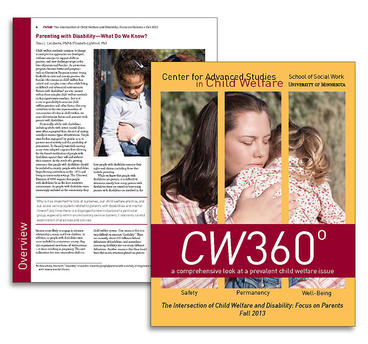
Child Welfare 360° (CW360°) is an annual publication that uses a multidisciplinary approach for its robust examination of an important issue in child welfare practice. This box includes an issue focused on the experiences of parents with disabilities and mental illness in the child welfare system.
Fall 2013 Publication: The Intersection of Child Welfare and Disability: Focus on Parents (CW360°)
Box 4: Client Engagement in Child Welfare
Training Resource Card
Video Tutorials for Practice Tools: Within this resource page, view digital copies and helpful video tutorials for many of the practice tools included in this box. The materials found here help practitioners develop skills related to relationship-building within family engagement and partnership in child welfare.
Online Modules & Webinar: The online modules and webinar highlight additional techniques for engaging families plus an in-depth workshop that considers engagement when working with children or parents who have been affected by substance use.
- Module #1: Motivational Interviewing Techniques in Child Welfare
- Module #2: Engaging Families and Children in Prevention and Early Intervention Services
- Webinar: Supporting Parents in their Recovery Journey
Practice Notes
Practice Notes: Practice Notes are developed in collaboration between CASCW affiliates and public child welfare practitioners. They are intended as a reference for child welfare professionals, linking research with best practices.
Practice Tips
Practice Tips: These resources were developed in partnership with the Center for Practice Transformation with the goal of empowering child welfare workers looking to integrate person-centered practice into their work with children and families.
Practice Tools
Stage-Matched Support Resource: This resource is a “map” to help you identify where a person is on their journey of making a change. This knowledge equips you to use stage-matched support skills and strategies to help them move forward in a sustainable way.
Powerful Questions Resource: By shifting our focus from providing answers to asking powerful questions, we create a safe space to explore possibilities, encourage discovery, achieve deeper understanding, and evoke new insights. This resource offers a brief selection of powerful questions to support your practice of being an agent of positive change.
Scaling Tool for Child Welfare Professionals: The Scaling Tool is an instrument for discussion that offers a way to explore an individual’s experiences and “wants.” It includes questions that are helpful conversation starters.
Integrating Motivational Interviewing in Case Planning with Youth in Foster Care: Motivational interviewing (MI) is an approach that can be used to promote the characteristics and skills that contribute to youth’s resilience and positive outcomes and can be helpful when youth struggle with completing tasks or engaging in behaviors that support a successful transition from foster care. This quick reference card was developed to help child welfare professionals integrate MI in their everyday practice.
Today Cards: The Today Card provides a variety of prompts intended for individual and group reflection. This product can serve as a tool to encourage discussion and meaningful learning in training, group, or supervision settings.
Character Strengths Cards: Exploring and identifying a person’s unique strengths can inspire hope, strengthen engagement, and help to build an alliance between workers and clients. Character Strength Cards can be used in a variety of ways; one method involves asking a client to select the three cards that they feel most represent their top strengths and discussing how they can use those strengths to address a current challenge.